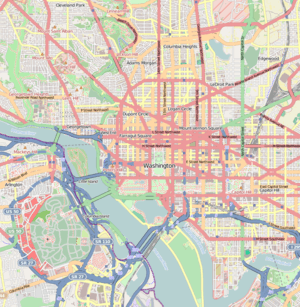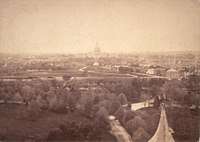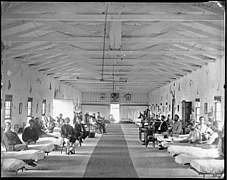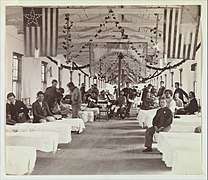Armory Square Hospital
| Armory Square Hospital | |
|---|---|
| Part of military hospitals in the United States | |
| Washington, D.C. | |
 | |
 Armory Square Hospital | |
| Coordinates | 38°53′16″N 77°01′14″W / 38.8877778°N 77.0205556°W |
| Site information | |
| Controlled by | Union Army |
| Site history | |
| Built | 1862 |
| In use | 1862–1865 |
| Demolished | 1964 |
| Battles/wars | American Civil War |
The Armory Square Hospital formally known as the District Armory or Armory of the District of Columbia was a military hospital for the Union Army located on the National Mall in Washington, D.C. which operated from 1862 to 1865. It stood at the intersection of 6th Street SW and B Street SW (now Independence Avenue) between the Smithsonian Castle and the Capitol. The 12 wards extended across the Mall, all the way to the Canal. Today, the National Air and Space Museum stands in its place.
History
The Armory

On March 11, 1856, President Franklin Pierce sends a message to the Senate Committee on Military Affairs with information a suitable location for an Armory for "the preservation of ordnance, arms, etc., in Washington". The report is passed from the Ordnance Officer to Secretary of War Jefferson Davis and then to the President. Five sites are analysed and the second one is recommended.[1]
The next locality examined is at the intersection of B street south and Sixth street west, north of the former street and west of the latter. This site is nearly central, the ground is level and firm enough for building on, access from other parts of the city easy, and there would be ample space on the government reservation contiguous to the site not only for future extension of the building, but for military parade grounds, with little hazard of these two advantages of space being trenched upon by other improvements.[1]
Based on these recommendations, the Armory is built that same year next to the canal. The amount of space available would provide useful a few years later. How ever the canal had fallen into disuse and was in essence an open sewer for the city.
The Hospital

In 1861, the Civil War begins. At the request of President Abraham Lincoln, Doctor Willard Bliss organizes a system of hospitals in and around the city.[2] In 1862, the Armory Square Hospital was built on the land surrounding the Armory and took its name.
It offered 1,000 beds in twelve wards (barracks) and overflow tents to treat the wounded from the battlefields of Virginia. Wounded soldiers were brought across the Potomac River to the city wharves in southwest Washington , DC including the Fish Wharf as well as on the Long Bridge which landed at the other end of Maryland Avenue SW a few blocks away. In addition to these barracks, quarters for officers, service facilities and a chapel where built on site.[3]
It was one of several hospitals in the city used to treat the wounded. Since it was the closest to the arrival points for the steamboats, it was often the place where the most wounded remained as they were unable to travel any further. Volunteers from the northern States came to provide assistance in the hospitals including the Armory as nurses as well as support staff. Dr. Bliss became the superintendent for the hospital and remained to practice in the city after the war. [4]
The poet Walt Whitman volunteered at the Armory Square Hospital. He made his way from New York to Washington, DC after reading that his brother might have been wounded. After finding him, he began volunteering as part of the Christian Commission in the city hospitals, visiting wounded soldiers and developing close relationships with many of them and raising money for provisions for them. This experience would have a profound influence on him and his later writings.[5] In The Wound Dresser, he writes:
I devote myself much to Armory-square hospital because it contains by far the worst cases, most repulsive wounds, has the most suffering and most need of consolation. I go every day without fail, and often at night - sometimes stay very late.[6]
The hospital was close to the White House and was visited on one occasion by President Lincoln in 1863 as reported by Amanda Akin Stearns in her memoir "The lady nurse of Ward E" published in 1909:
It was pathetic to see him pass from bed to bed and give each occupant the warm, honest grasp for which he is noted. I hear that he is especially interested in this hospital, and has suggested having flower beds made between the wards with plants from the Government gardens, which Dr. Bliss is having done. His homely face with such sad eyes and ungainly figure did not fill my youthful idea of a "President of the United States" ; but it was a grand thing for him to come and cheer our soldier boys with his presence. [2]
On January 6, 1864, the first issue of the Armory Square Hospital Gazette was published. In an article entitle Salutatory, the author writes:
the Hospital is an episode in soldier’s life--sometimes a painful termination of it, which has many an event worthy of a chronicle. Such we propose this paper to be. [7]
The gazette went on for several months, offering reading, news to the patients and a little recognition to the staff. The last issue is published on the 21 August 1865. By the summer of 1865, the hospital was no longer needed with the end of hostilities ending on May 9, 1865. The numbers of patients were reducing and other hospitals would remain open longer. In an article announcing the closure of the hospital, the author writes:
During the last three years, thousands of our brave soldiers have been inmates of Armory Square [...] One cannot conceive of a gun-shot wound that has not been treated here. Of nearly every disease in the catalogue we have had examples. Such an opportunity for the practice of surgery, or the study of pathology and the treatment of disease, will not probably occur again soon. God grant that the stern emergency of a bloody civil war, which rendered so many asylums for our wounded and sick soldiers a necessity, may never again arise to curse with its mildew blights our native land.
We now bid adieu to Armory Square—but not without some regrets [...] Within its walls we have learned many a lesson of wisdom, of patience under suffering—of the keenest grief—of faith, forgiveness, of true manhood [8]
 Patients in Ward K
Patients in Ward K Some of the wounded soldiers in a Ward
Some of the wounded soldiers in a Ward The Wards, Chapel and other buildings
The Wards, Chapel and other buildings The Wards
The Wards- The Chapel and other buildings
The Armory Building was used for a time as a storage facility and then became the United States Fish Commission. Finally in January 1964, it was demolished to make way to the National Air and Space Museum.[3]
See Also
References
- 1 2 Index of the Executive Documents Printed by Order of the Senate of the United States, First and Second Sessions Thirty-Fourth Congress - 1855–1856 - page 10
- 1 2 The Lady Nurse of Ward E - Amanda Akin Stearns
- 1 2 Historic Medical Sites in the Washington, DC Area – NIH – U.S. National Library of Medicine - https://www.nlm.nih.gov/hmd/medtour/armory.html
- ↑ Whitman, Walt; Miller, Edwin Haviland (2007). The Correspondence: Volume I: 1842–1867. New York, NY: New York University Press. p. 91. ISBN 0-8147-9421-1.
- ↑ Revising Himself: Walt Whitman and Leaves of Grass - Wound Dresser - Library of Congress - https://www.loc.gov/exhibits/whitman/wounddresser.html
- ↑ The Wound Dresser: A Series of Letters Written from the Hospitals in Washington During the War of the Rebellion - Walt Whitman - 1898 - page 89
- ↑ Armory Square Hospital Gazette - 6 January 1864 - The Thomas Biggs Harned Collection of the Papers of Walt Whitman, Library of Congress, Washington, DC
- ↑ Armory Square Hospital Gazette - 21 August 1865 - Center for the History of Medicine, Countway Library of Medicine, Harvard University